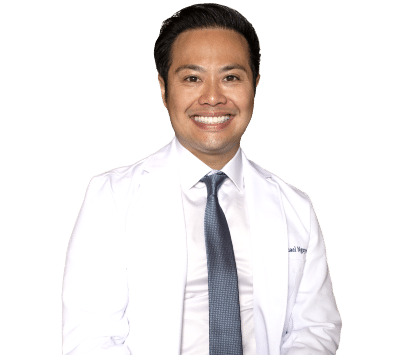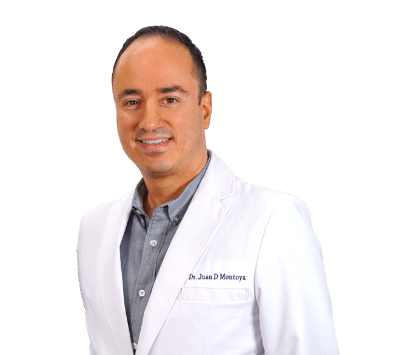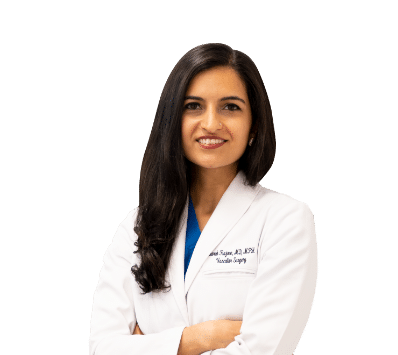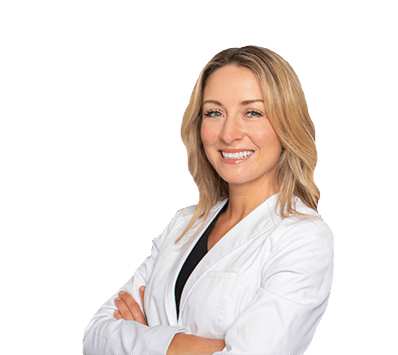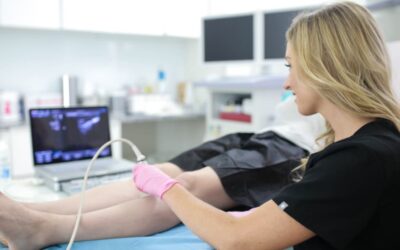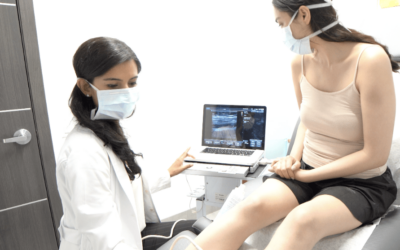Varicose Vein Treatment Without Surgery: Benefits, Options, and Process
If you’re dealing with varicose veins, you’re not alone. Varicose veins are swollen, twisted veins that often appear blue or purple. They most commonly occur in the legs and are the result of damaged or weakened vein walls and malfunctioning valves within the veins. Healthy veins have valves that keep blood flowing in one direction—toward the heart. When these valves become weak, blood can flow backward and pool in the veins, causing them to bulge.
At New York Vein Treatment, our board-certified vein doctors specialize in providing minimally invasive varicose vein treatments that don’t require surgery. We have state-of-the-art offices in Midtown Manhattan and FiDi — please schedule an appointment at your nearest medical center for vein treatment in New York City.
The Importance of Seeking Treatment
Varicose veins can cause a range of symptoms and complications, including:
- Pain and discomfort: Many individuals with varicose veins experience aching, throbbing, and heaviness in their legs, especially after prolonged periods of sitting or standing.
- Swelling: Varicose veins can lead to swelling in the legs and ankles.
- Skin changes: Varicose veins can cause skin discoloration and even ulcers in severe cases.
- Blood clots: In some instances, varicose veins can increase the risk of blood clots, which can be life-threatening if they travel to the lungs or other vital organs.
Varicose veins are often symptomatic of chronic venous insufficiency (CVI), a dangerous medical condition caused by collapsed vein valves. When the vein valves weaken, blood flows backward due to gravity and accumulates in the leg veins. This is a dangerous, chronic condition that worsens with time. As such, the longer you delay the treatment, the worse the symptoms will become. That’s why you need prompt varicose vein treatments.
Vascular Surgery: The Obsolete Option
In the past, surgical procedures were often the go-to approach for treating varicose veins. However, advancements in medical technology have rendered traditional vascular surgery an increasingly obsolete option. These invasive procedures, such as vein ligation and vein stripping, involve making incisions to access the affected veins.
In vein ligation, the targeted vein is tied off to prevent blood flow, while in vein stripping, the vein is physically removed from the body. While effective in some cases, these procedures are associated with more discomfort, longer recovery times, and a higher risk of complications compared to modern, minimally invasive treatments.
Drawbacks of Vein Surgery:
- Invasive Nature: Traditional vein surgery typically involves large incisions, resulting in more significant tissue damage and scarring compared to minimally invasive options.
- Prolonged Recovery: Patients undergoing vein surgery often face extended recovery periods, requiring more time off work and daily activities.
- Higher Risk of Complications: Surgical procedures come with inherent risks, including infection, bleeding, and adverse reactions to anesthesia.
- General Anesthesia: Many vein surgeries require general anesthesia, which can pose additional risks and discomfort to patients.
- Limited Efficacy: Surgical treatments may not address the root cause of varicose veins as effectively as modern, non-surgical options.
- Cosmetic Concerns: The scarring and visible signs of surgery can be a cosmetic concern.
- Long-Term Impact: Surgical interventions may not provide long-term relief, with varicose veins potentially recurring over time.
- Discomfort: Post-operative pain and discomfort can be more significant in surgical procedures compared to minimally invasive treatments.
- Hospitalization: Some vein surgeries may require hospital stays, adding to the overall cost and inconvenience of the treatment.
Minimally Invasive Vein Treatments: The Gold Standard of Vein Care
-
Minimally invasive treatments have risen to become the gold standard, offering patients a host of advantages over traditional surgical options. These cutting-edge procedures have redefined how we address varicose veins and spider veins, providing a level of comfort and effectiveness that surgery simply can’t match. They require smaller incisions or none at all, reducing tissue damage, scarring, and post-procedure discomfort.
The recovery period is significantly shorter, allowing patients to return to their daily activities quickly. Moreover, the lower risk profile, absence of general anesthesia, and excellent long-term results make these treatments the go-to option for those seeking relief from varicose veins without the drawbacks associated with surgery.
Benefits of Minimally Invasive Vein Treatments:
-
- Minimally Invasive: Non-surgical treatments are minimally invasive, meaning they involve small incisions or no incisions at all. This leads to faster recovery times.
- Lower Risk: Surgical procedures often come with higher risks of complications, such as infection or anesthesia-related issues. Non-surgical treatments have a lower risk profile.
- No General Anesthesia: Most non-surgical varicose vein treatments are performed under local anesthesia or mild sedation, reducing the risks associated with general anesthesia.
- Shorter Recovery: Patients typically recover faster after non-surgical procedures, allowing them to return to their daily activities sooner.
Effective: Non-surgical treatments, such as endovenous laser ablation, radiofrequency ablation, and VenaSeal, have proven to be highly effective in treating varicose veins and underlying chronic venous insufficiency and relieving symptoms
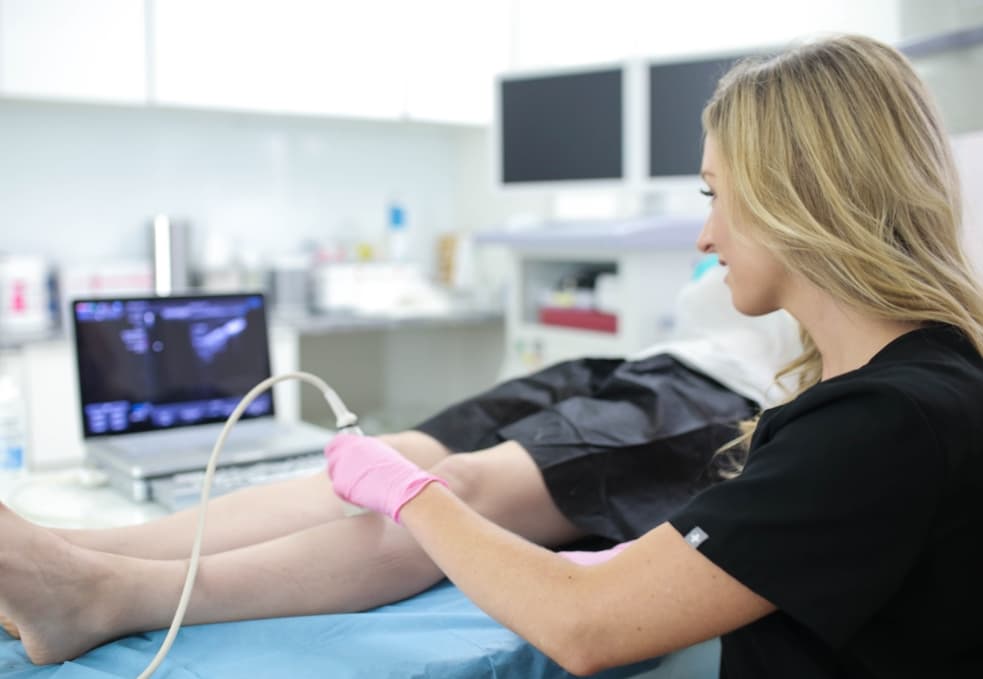
Non-Surgical Varicose Vein Treatment Options
Sclerotherapy:
- Procedure involves injecting a solution directly into the spider veins or small varicose veins.
- The solution irritates the vein walls, causing them to stick together and eventually close off.
- Blood is rerouted to healthier veins, and the treated vein is gradually absorbed by the body.
- Suitable for smaller varicose veins and spider veins.
Endovenous Laser Ablation (EVLA):
- A laser fiber is inserted into the affected vein under ultrasound guidance.
- Laser energy is delivered to heat and seal the vein.
- The treated vein collapses, and blood is rerouted to healthy veins.
- Effective for larger varicose veins and underlying vein disease.
Radiofrequency Ablation (RFA):
- A thin catheter is inserted into the varicose vein.
- Radiofrequency energy is applied to heat and seal the vein.
- The vein closes off, and blood is redirected to healthier veins.
- Suitable for larger varicose veins and underlying vein disease.
VenaSeal:
- A medical adhesive is injected into the affected vein.
- The adhesive seals the vein shut.
- Blood is rerouted to functioning veins.
- VenaSeal is a relatively new and innovative treatment option.
Ambulatory Phlebectomy:
- Also known as microphlebectomy.
- Involves the removal of superficial varicose veins through tiny incisions.
- Ideal for surface varicose veins that are visible beneath the skin.
The Treatment Process
Consultation and Diagnosis:
- We begin with a thorough consultation to understand your symptoms and medical history.
- Duplex ultrasound is used to diagnose the underlying vein issues.
- We also offer free insurance verification, ensuring you have a clear understanding of your coverage even before your first appointment.
Treatment Day:
- We’ll walk you through the procedure, answer any questions, and address concerns.
- Local anesthesia or mild sedation is administered to keep you comfortable.
- The chosen treatment is performed by our vein doctor, targeting the problematic veins.
Recovery:
- You’ll be monitored briefly to ensure there are no immediate issues.
- You can usually return home the same day.
- Most patients can resume light activities immediately and workouts within a week.
- Your doctor will provide specific post-procedure care instructions, which may include wearing compression stockings and avoiding strenuous activities for a certain period.
Follow-up:
- We schedule follow-up appointments to assess your progress.
- Additional treatments may be recommended if necessary.
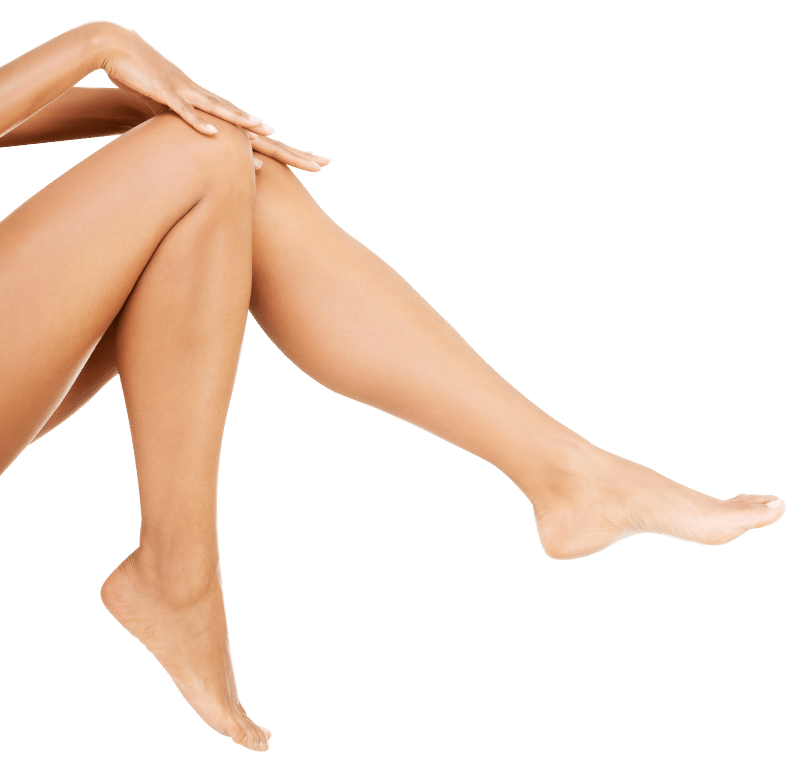
BOOK AN APPOINTMENT
Experiencing symptoms of vein disease? Book an appointment with one of the our Vein Specialists in New York.
Your information is encrypted and secure. By registering you confirm that you accept Terms and Conditions and Privacy Policy
Minimally Invasive Vein Treatment FAQs
What are minimally invasive vein treatments?
Minimally invasive vein treatments are non-surgical procedures designed to treat varicose veins and spider veins using advanced techniques like laser energy, radiofrequency, medical adhesive, or injections. These treatments offer a less invasive alternative to traditional surgery.
Are minimally invasive treatments painful?
Most patients report minimal discomfort during minimally invasive vein treatments. Local anesthesia or mild sedation is typically used to ensure your comfort during the procedure. Afterward, any discomfort is usually mild and manageable with over-the-counter pain relievers.
How long does a minimally invasive vein treatment take?
The duration depends on the specific treatment and the number of veins being treated. In general, most minimally invasive vein treatments can be completed within one to two hours.
What is the recovery time after a minimally invasive vein treatment?
Recovery times vary depending on the treatment and individual factors, but patients can often resume light activities within a day or two. Strenuous activities should be avoided for a few weeks, and wearing compression stockings may be recommended during the healing process.
Are the results of minimally invasive treatments permanent?
Minimally invasive treatments are highly effective, and the results are typically long-lasting. Treated veins are sealed off or removed, reducing the likelihood of them recurring. However, new veins may develop over time, and periodic follow-up appointments may be necessary.
Will I need multiple treatment sessions?
The number of treatment sessions required depends on the severity of your vein condition and the treatment plan your doctor recommends. Some patients achieve desired results with a single session, while others may require additional treatments to achieve optimal outcomes.
Is there a risk of complications with minimally invasive vein treatments?
While complications are rare, all medical procedures carry some level of risk. Minimally invasive vein treatments have a lower risk profile compared to surgery, with potential complications including bruising, swelling, or minor skin discoloration, which typically resolve on their own.
Contact Us for Non-Surgical Varicose Vein Treatments
Varicose vein treatment without surgery has revolutionized the way we address this common vascular condition. At New York Vein Treatment, our board-certified vein doctors offer a range of minimally invasive options, including sclerotherapy, endovenous laser ablation, radiofrequency ablation, VenaSeal, and ambulatory phlebectomy.
Leaving varicose veins untreated can lead to discomfort, complications, and a decreased quality of life. Contact us today for a consultation, and we’ll create a personalized treatment plan. Our conveniently located medical centers in Midtown Manhattan and the Financial District are here to serve you, offering expert care and the latest varicose vein treatments.
MEET OUR NEW YORK
VEIN SPECIALISTS
Dr.MICHAEL NGUYEN
Veins Specialist NYC
He leads the team of vein doctors offering the highest level of care at our Spider and Varicose Vein Treatment Center NYC.
HARVARD MEDICAL SCHOOL
Dr. JUAN D. MONTOYA
Veins Specialists NYC
Highly sought after for his expertise and excellent outcomes in Vein Treatments in Manhattan.
YALE MEDICAL SCHOOL
Dr. SAREH RAJAEE
Veins Specialists NYC
She has extensive experience with vein performing procedures based on New York City.
HARVARD MEDICAL SCHOOL
Learn more about our clinics, doctors and procedures!

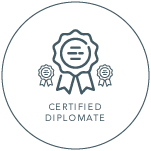

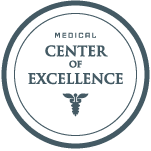



Contact us
Call us
Speak instantly with one of our team members; they will answer any questions you may have regarding insurance coverage, booking an appointment and our vein treatment locations. (646) 859-1833
Book online
Visit our Book Appointment page and instantly request an appointment at the New York vein center near you. We offer Free Insurance Verification before your appointment.
Get directions
Learn how to easily get to the New York vein center.
FEATURED POSTS BY VEIN DOCTORS
Get the Results You Want with Our Vein Treatments
Get the Results You Want with Our Vein Treatments If you're dealing with varicose veins or spider veins, you're not alone. Fortunately, New York Vein Treatment is here to help you achieve the results you want with our minimally invasive vein treatments. Led by...
Sclerotherapy: Spider Vein Treatment That Works
Sclerotherapy: Spider Vein Treatment That Works Are you tired of those unsightly spider veins that seem to appear out of nowhere on your legs, making you self-conscious about wearing shorts or skirts? Spider veins, those small, red, blue, or purple veins that often...
The Best Vein Treatment in New York City
The Best Vein Treatment in New York City If you're dealing with the discomfort and unsightly appearance of varicose and spider veins, you're not alone. Millions of people in New York City and around the world are affected by these vein issues. Let's explore the best...
Varicose Vein Treatment Cost with Insurance: What You Need to Know
Varicose Vein Treatment Cost with Insurance: What You Need to Know If you're dealing with varicose veins or spider veins, you're not alone. These common vein conditions affect millions of Americans. At New York Vein Treatment, we understand the importance of getting...
